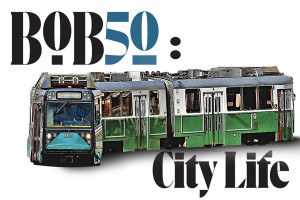What’s Wrong with the Charles River Esplanade?
For those not fortunate enough to live along the leafy avenues of the Back Bay, the Esplanade is a perfectly lovely stretch of park you might walk through occasionally or visit to take in a summer concert at the Hatch Shell. But to the Esplanade Association, it’s “a vision interrupted,” a 19th-century masterpiece that now “looks like something from the 1950s.” Last night before a packed crowd at the Boston Public Library’s Rabb Auditorium, the association unveiled “Esplanade 2020,” an audacious first draft for a plan that would go far beyond re-sodding a few bits of grass — and remake the city almost as dramatically as the Big Dig.
Why now? Over the next 10 and 20 years, everything from the Storrow Drive tunnels to the Longfellow Bridge, sections of the MassPike, and the Bowker Overpass (the elevated roadway north of Kenmore Square that connects Storrow Drive to the Fenway) will require overhaul, expansion, or outright replacement. With an integrated long-term vision, the association’s experts argue, we have a “once in a century opportunity” to remake the Esplanade into what could be “the very best park in the world.”
The larger changes envisioned by the plan include, in no particular order, removing the Bowker Overpass to connect the Fens directly to the Esplanade, moving the garage at the Museum of Science and replacing it with a park, adding new Masspike exits to provide more direct access to the Back Bay and Longwood Medical Area, dramatically downsizing Storrow Drive to a low-speed parkway, and, just maybe, building a huge Ferris wheel somewhere in there. Somewhere along the way, the Hatch Shell, BU and Community Boating boathouses, and the Lee Pool would all get replaced or refurbished, and an indoor/outdoor cafe behind the Hatch Shell would also appear.
The Q+A portion of the meeting began with Sheldon Young, an grandfatherly Bostonian who commented that, since our memories were often bound inextricably with music, “May I suggest an original song?” He then added, “I have such a song,” and broke into a two-minute aria that suggested Moon River as it might be sung by Mumbles Menino. The audience gave Young an ovation, and it was perhaps the only part of the evening all sides truly agreed upon.
As with any Boston planning project, Esplanade 2020 was long on appeals on everything from Chicago’s Millenium Park to the High Line in NYC, the banks of the Seine, and of course, London. It’s perhaps a good sign that we’re shifting our locus of envy from our southern sports bete noire to the capital of imperial Britain, but the crowd of cantankerous bluebloods in attendance were decidedly skeptical. Back Bay resident Peter Sharon spoke in favor of “pristine space preserved” and worried that the plans on display would turn the Esplanade into an ersatz “Disneyland.”
Sharon’s comment was followed by John Winthrop Sears, whom the moderator introduced as “the venerable commissioner.” Speaking in a luscious Brahmin baritone, this last of the great woolly mammoths said that he saw “a little too much architecture in the pictures,” drawing sustained applause. Committee member John Shields replied that everything in the presentation, including the cafe, was “just a replacement” of existing structures or original parts of the park that had been let go over the years. Well, everything except for the Ferris wheel, which the panelists repeatedly reminded the audience was — like the rest of the presentation — just an idea.
While Shields concluded the meeting by telling everyone that this process could be one where everybody came out a winner and that everyone’s self-interest could be satisfied while advancing the overall objective, it’s clear that large and difficult questions remain. Aside from funding, the true requirements of which were not discussed, much of the vision revolves around a near-total re-thinking of Storrow Drive, which today carries as much traffic along the Charles as the much larger MassPike. Re-routing that volume of traffic won’t happen easily without major changes elsewhere, sure to spark Big Dig-like neighborhood objections.
And even if we can all agree on shrinking Storrow, the audience questions revealed a classic fault line between those who believe they’re defending a vision of the park as it always was. But as the discussion showed, the Esplanade of the past few decades is itself a significant change from the vast and lively turn-of-the-20th-century promenade it originally was.



